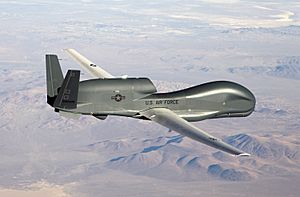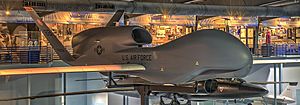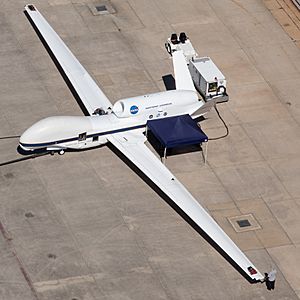Northrop Grumman RQ-4 Global Hawk facts for kids
Quick facts for kids RQ-4 Global Hawk |
|
|---|---|
 |
|
| An RQ-4 Global Hawk flying in 2007 | |
| Role | Unmanned surveillance and reconnaissance aerial vehicle |
| National origin | United States |
| Manufacturer | Northrop Grumman |
| First flight | 28 February 1998 |
| Introduction | November 2001 |
| Status | In service |
| Primary users | United States Air Force NASA NATO |
| Produced | 1998–present |
| Number built | 42 RQ-4Bs as of FY2013 |
| Program cost | US$10 billion (USAF cost through FY2014) |
| Unit cost | US$131.4M (FY13) US$222.7M (with R&D) |
| Developed into | Northrop Grumman MQ-4C Triton |
The Northrop Grumman RQ-4 Global Hawk is a special type of aircraft called a drone. It flies very high and is controlled by people on the ground, not by a pilot inside. It was first used in 2001.
The Global Hawk is like a giant eye in the sky. It uses powerful cameras and radar to look at large areas of land. It can see things very clearly, even from far away. It can watch an area as big as South Korea or Iceland in just one day!
The United States Air Force (USAF) uses the Global Hawk. Its main job is to gather information and help protect soldiers on the ground. Because it can see so much, it helps the military aim weapons more accurately and keep friendly forces safer.
Over time, the cost of building these drones went up. Because of this, the Air Force decided to buy fewer of them than they first planned. The U.S. Navy also created a special version of the Global Hawk called the Northrop Grumman MQ-4C Triton. This version is used to watch the oceans. The U.S. Air Force plans to stop using its Global Hawks by 2027.
Contents
Design
How it's Built
The Global Hawk system includes the RQ-4 aircraft itself, which carries many sensors and communication tools. It also has a ground team that controls it. This team uses a Launch and Recovery Element (LRE) to get the drone into the air and land it. They also use a Mission Control Element (MCE) to guide it during its flight.
Each RQ-4 Global Hawk has one turbofan engine. This engine gives it enough power to carry a payload (like its sensors) weighing up to 2,000 pounds (910 kilograms). The main body of the aircraft is made of aluminum. Its wings are made from strong, lightweight materials.
Different Versions
There have been several versions of the Global Hawk, each with new features.
- The first version used in missions was the RQ-4A Block 10. It had a 2,000 lb (910 kg) payload with a special radar (SAR) and cameras (EO/IR). All seven of these older models were retired by 2011.
- The RQ-4B Block 20 was the first of the newer, larger B-models. It could carry a heavier payload of 3,000 lb (1,400 kg) and had improved sensors. Four of these Block 20s were changed to act as communication relays, helping other aircraft talk to each other.
- The RQ-4B Block 30 can collect many types of information. It has the SAR and EO/IR sensors, plus a special sensor to listen for electronic signals.
- The RQ-4B Block 40 has an advanced radar system. This radar can see both still and moving targets over a very wide area.
The Global Hawk can fly for a very long time, sometimes more than 30 hours! Because it flies so high, it doesn't get as much wear and tear as planes that fly lower.
Ground Control and Sensors
The Global Hawk uses a special set of sensors called the Integrated Sensor Suite (ISS). These sensors include:
- A synthetic aperture radar (SAR): This radar can create images even through clouds or at night.
- Electro-optical (EO) cameras: These are like very powerful digital cameras.
- Infrared (IR) cameras: These cameras see heat, which helps them see in the dark.
The EO or IR cameras can work at the same time as the SAR. Each sensor can search a wide area or focus on a small spot with high detail. The SAR also has a mode that can find moving targets on the ground. It can even send a text message with the target's location and speed.
The Global Hawk's camera is so powerful it can spot objects on the ground as small as 30 cm (12 in) (about a foot) from 20 km (66,000 ft) (about 12 miles) up in the air!
The Global Hawk can fly by itself, without constant commands from the ground. It uses military satellites to send its information back to the control center. If it's close enough, it can also send images directly to ground stations. In busy airspaces, pilots on the ground can take control using the satellite link. They see the same flight information as if they were in the plane.
The ground control system has two main parts:
- The Mission Control Element (MCE): This is where people plan the missions, control the drone, and look at the images it sends back.
- The Launch and Recovery Element (LRE): This part helps the drone take off and land very precisely.
These two parts can be in different places. Both are set up in military shelters with antennas to talk to the drone.
Radar Systems
The Global Hawk carries a special radar system called HISAR. This system is very good at seeing things on the ground. It can work in different ways:
- A wide-area mode to find moving targets.
- A mode that combines radar and moving target detection to create detailed images over wide strips of land.
- A spot mode for very high-resolution images of small areas.
In 2006, the Air Force started testing new upgrades for the Global Hawk Block 30. These included a very sensitive sensor for collecting electronic signals. The Block 40 aircraft also got a new radar system called MP-RTIP, which is great for watching large areas.
In 2014, a Block 40 Global Hawk successfully tested new "Maritime Modes." These modes help the radar find and create images of ships and boats on the ocean. This helps the Air Force keep an eye on what's happening at sea.
In 2015, the Global Hawk fleet started getting new weather radars. These radars help the operators see storms, heavy rain, and even turbulence. This helps them fly the drone safely. All Global Hawks had these weather radars installed by late 2019.
Visible Light and Infrared Cameras
The Global Hawk has cameras that see in regular visible light and in infrared (heat). These cameras are in the same special package and use the same lenses. This allows them to zoom in for close-up views. The drone can also carry an extra sensor to collect electronic signals if needed.
Variants

Here are some of the different versions of the Global Hawk:
- RQ-4A
- This was the first version built for the U.S. Air Force. Sixteen of these were made.
- RQ-4B
- This is an improved version. It can carry more weight, and its wings are longer (130.9 ft (39.9 m)). Its body is also longer (47.7 ft (14.5 m)). Because it's bigger and carries more, it flies a slightly shorter distance, about 8,700 nmi (16,100 km).
- RQ-4D Phoenix
- This version is used by NATO (North Atlantic Treaty Organization) for ground surveillance.
- RQ-4E Euro Hawk
- This version was made for Germany's military. It was based on the RQ-4B and had special sensors for collecting electronic signals. Germany canceled most of its order, receiving only one of five planned Euro Hawks.
- EQ-4B
- This version is equipped with a special communication system called BACN. It acts like a flying cell tower, helping different military units talk to each other.
- KQ-X
- This was a proposed idea for a Global Hawk that could refuel other aircraft in the air.
- Model 396
- This was a smaller, armed version of the RQ-4A. It was about half the size. However, the military chose a different drone, the MQ-9 Reaper, instead.
Specifications (RQ-4B Block 30/40)
Data from Northrop Grumman USAF
General characteristics
- Crew: 0 onboard (3 remote: Launch and Recovery Element (LRE) pilot; Mission Control Element (MCE) pilot and sensor operator)
- Capacity: 3,000 lb (1,360 kg)
- Length: 47.6 ft (14.5 m)
- Wingspan: 130.9 ft (39.9 m)
- Height: 15.3 ft (4.7 m)
- Empty weight: 14,950 lb (6,781 kg)
- Gross weight: 32,250 lb (14,628 kg)
- Powerplant: 1 × Rolls-Royce F137-RR-100 turbofan engine, 7,600 lbf (34 kN) thrust
Performance
- Maximum speed: 391 mph (629 km/h; 340 kn)
- Cruise speed: 357 mph (575 km/h; 310 kn)
- Range: 14,155 mi; 22,780 km (12,300 nmi)
- Endurance: 34+ hours
- Service ceiling: 60,000 ft (18,000 m)
- Lift-to-drag: 33
See also


